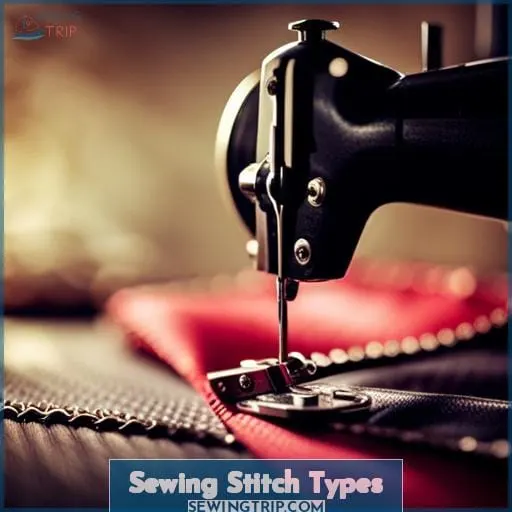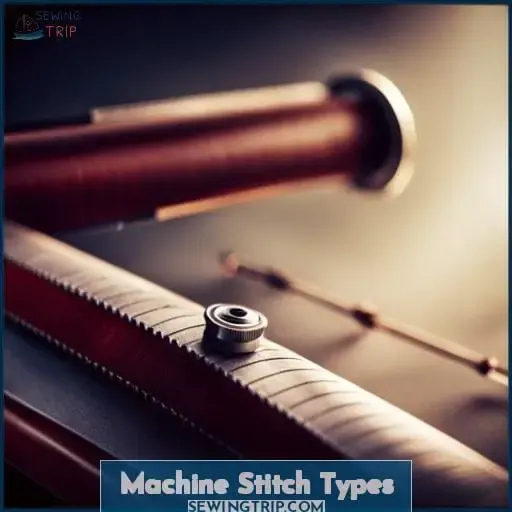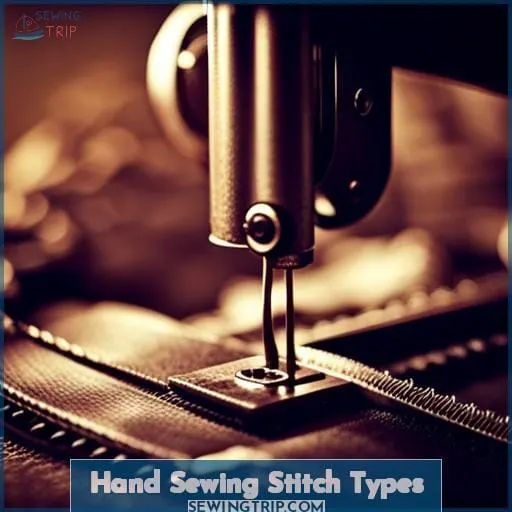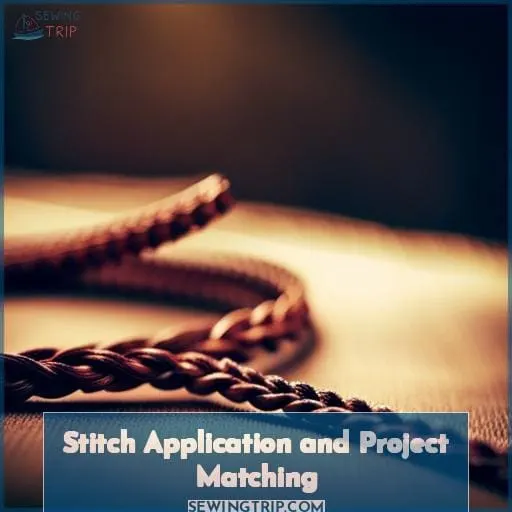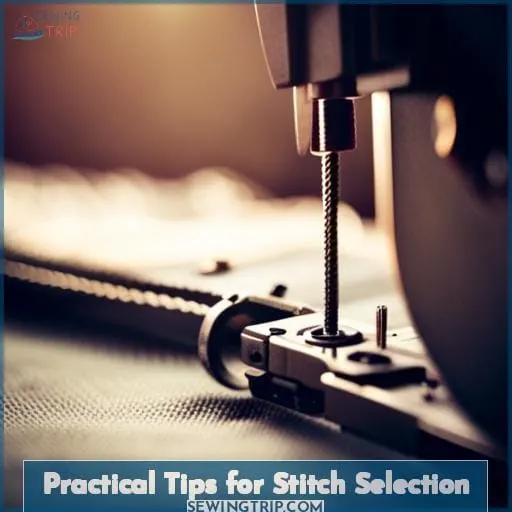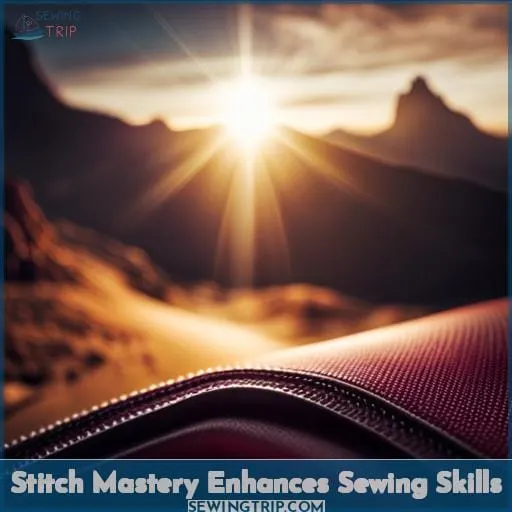This site is supported by our readers. We may earn a commission, at no cost to you, if you purchase through links.
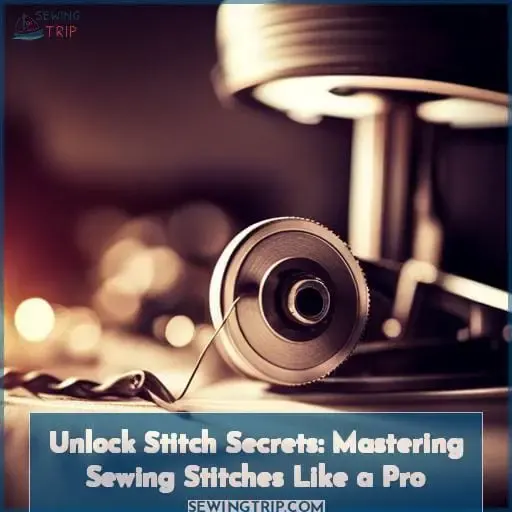 Imagine yourself as a master conductor, leading an orchestra of stitches, each contributing its unique melody to the symphony of your creation.
Imagine yourself as a master conductor, leading an orchestra of stitches, each contributing its unique melody to the symphony of your creation.
In this journey of sewing mastery, unlocking the secrets of stitch types is akin to learning the language of fabric, enabling you to articulate your designs with precision and artistry.
From the straight stitch, the backbone of construction, to the delicate whip stitch, the mender of tears, each stitch holds a story, a purpose, waiting to be discovered.
Embark on this exploration, and transform yourself into a maestro of stitches, composing garments and crafts that sing with beauty and durability.
Table Of Contents
Key Takeaways
- Stitch selection depends on project purpose, materials, intended use, and fabric properties.
- Machine and hand stitches have unique applications and advantages, affecting speed, efficiency, precision, and versatility.
- Mastering various stitches enhances sewing skills, enabling adaptation to different projects and fabrics, preventing fabric damage, and achieving desired aesthetics.
- Stitch diversity fosters creativity, allowing sewers to express personal style and transform sewing into an art form.
Sewing Stitch Types
Now that you’ve seen the sewing basics, let’s dive into the various stitch types.
They play a pivotal role in determining the stitch function, finish, quality, pattern, and design.
Machine stitches, with their efficiency and versatility, are categorized into:
- Straight
- Zigzag
- Overlock
- Buttonhole
- Basting/gathering stitches
Hand stitches, offering precision and control, include:
- Running
- Backstitch
- Whip
- Blanket
- Catch stitches
Each stitch type possesses unique characteristics, making it suitable for specific fabrics, projects, and desired outcomes.
Understanding these stitch types empowers you to select the perfect stitch for your project, ensuring impeccable results and unlocking your true sewing potential.
Machine Stitch Types
Now, let’s examine the main types of machine stitches:
- Straight stitch
- Zigzag stitch
- Overlock stitch
- Buttonhole stitch
- Basting/gathering stitch
Each stitch type has unique characteristics and applications. Understanding them will help you select the right stitch for your project and achieve professional-looking results.
Straight Stitch
With its versatility and ease of use, the straight stitch has you covered for basic sewing and intricate projects alike.
Its stitch length can be adjusted to suit the fabric type, seam strength, and desired decorative effects.
Whether you’re a beginner or an experienced sewist, the straight stitch is your go-to for everything from basic seams to intricate sashiko stitching.
Master this fundamental stitch, and you’ll have a solid foundation for your sewing journey.
Zigzag Stitch
Next, you’ll learn about the zigzag stitch, its versatility, and how it prevents fabric puckering.
With adjustable width and length settings, this stitch is a master of flexibility.
Say goodbye to puckered seams and frayed edges, and hello to neat finishes and creative embellishments.
Unleash your creativity with a variety of patterns, from simple to intricate, adding a personal touch to your projects.
Overlock Stitch
Second, the overlock stitch is your go-to choice for hemming and finishing fabric edges professionally.
This stitch trims, stitches, and overcasts the fabric in one fell swoop, preventing fraying and providing a neat, durable finish.
Overlock machines offer a range of stitch patterns and widths, allowing you to customize the look of your seams and edges.
While overlock stitches excel in elasticity and strength, they may not be suitable for all fabrics or projects due to their distinct appearance.
Buttonhole Stitch
Moving on to buttonhole stitches, you’ll discover a specialized stitch designed to create neat and secure buttonholes, ensuring your garments close effortlessly.
Explore various buttonhole stitch patterns and variations to suit different fabric types and buttonhole designs.
Master the art of sewing buttonholes with precision, troubleshooting common issues along the way.
Discover alternative methods for creating buttonholes, expanding your sewing repertoire.
Elevate your sewing skills by delving into the world of buttonhole stitches.
Basting/Gathering Stitch
Often used for temporary holds or gathers, the basting/gathering stitch quickly tacks fabric pieces together.
Basting stitch variations range from long, loose stitches for easy removal to shorter, tighter stitches for more secure holds.
Gathering stitch applications include creating ruffles, pleats, and shirring, adding fullness and texture to garments and home décor.
Temporary stitching techniques like basting and gathering allow for adjustments, alterations, and fittings before permanent stitching.
Adjustable stitch length accommodates different fabric weights and textures, ensuring optimal stitch performance.
Hand Sewing Stitch Types
Let’s turn our attention to hand sewing stitch types:
- Running stitch: A basic stitch used for quick mends and basting.
- Backstitch: A durable stitch for seams and hems.
- Whip stitch: Ideal for hemming thick fabrics or joining pieces.
Running Stitch
With Running Stitch, you’re privy to a basic hand sewing stitch’s versatility and ease of use.
This beginner stitch is your go-to for quick mends, attaching buttons, and basting fabrics together.
Picture this: needle through fabric, pulling thread through, creating a series of even stitches, one after the other.
Master this fundamental stitch, and you’ll unlock a world of sewing possibilities, from simple repairs to intricate projects.
Backstitch
Now that you’ve got the running stitch down, let’s move on to the backstitch, a more durable and secure hand sewing technique.
Backstitch stitches overlap, creating a strong and neat seam that’s less likely to unravel.
Plus, it can be used decoratively to add a unique touch to your projects.
Master this versatile stitch and unlock a world of sewing possibilities.
Whip Stitch
Next up in our hand-sewing repertoire is the whip stitch, a reliable and versatile tool for hemming thick fabrics and joining pieces together seamlessly.
Its variations, including the chain stitch, lock stitch, and catch stitch, offer diverse decorative applications.
Master the whip stitch to enhance your sewing skills and create strong, beautiful seams that stand the test of time.
Blanket Stitch
Next, let’s explore the blanket stitch, a classic hand-sewn technique ideal for finishing thick fabric edges and creating decorative accents.
With variations like faggoting, feather stitch, herringbone stitch, and web stitch, the blanket stitch opens up a world of embellishment possibilities.
Embark on a creative journey as you conquer this versatile stitch, transforming ordinary projects into works of art.
Catch Stitch
Next, try the catch stitch. This stitch is ideal for clean hemming on non-stretchy materials.
Master the zig-zag pattern on the inside for a secure finish. This stitch is a lifesaver for hemming thick fabrics like wool, providing a neat and polished look.
With practice, you’ll find the catch stitch isn’t just functional but also decorative, adding a touch of elegance to your handmade garments.
Stitch Application and Project Matching
When selecting a stitch, you’ll need to consider the project’s purpose and the materials you’re working with. There’s no one-size-fits-all stitch; the choice depends on the fabric, the intended use of the item, and the desired aesthetic.
Stitch Selection: Mastering various stitches empowers you to adapt techniques based on project requirements, yielding neater, stronger results.
Machine vs. Hand: Machine sewing and hand sewing both have distinct advantages. Machine sewing excels in speed and efficiency, while hand sewing offers precision and versatility for intricate details.
Stitch Application & Matching: Different stitches serve different purposes. Straight stitches excel in durability for high-wear items, while delicate stitches add finesse to decorative pieces.
Stitch Mastery: Stitch mastery elevates your sewing skills and project outcomes. Experimentation with various stitches adds an element of enjoyment to the sewing process, unlocking your creative potential.
Cross Stitch, Fly Stitch, Lazy Daisy, Long and Short Stitch, Seed Stitch: These are just a few examples of the diverse stitches available, each with its unique characteristics and applications.
Practical Tips for Stitch Selection
To select the right stitch, consider:
- Fabric type
- Project purpose
- Desired result
Machine sewing excels in:
- Efficiency
- Precision
Hand sewing offers:
- Versatility
- Control for intricate details
Matching the stitch to the project ensures:
- Durability
- Aesthetics
- Overall project success
Stitch Selection Factors
To select the right stitch for your sewing project, consider the following factors:
-
Fabric type:
- Choose stitches that suit the fabric’s weight and thickness.
- Delicate fabrics require finer stitches, while heavy fabrics need stronger ones.
-
Fabric stretchiness:
- Stretchy fabrics need stitches that can stretch with the material.
- Zigzag stitches are ideal for knits and other stretchy fabrics.
-
Intended use:
- Consider the project’s purpose and the level of durability required.
- Decorative stitches may be suitable for non-functional items, while durable stitches are best for high-wear garments.
Machine vs. Hand Sewing
Depending on your project, you’ll need to decide whether machine sewing or hand sewing is the better choice for the job.
Machine sewing excels in:
- Complex projects
- Durable stitches
- Working with stretchy fabrics
Hand sewing offers:
- Precision for intricate details
- Delicate fabrics
- Decorative elements like couching, fern, or fishbone stitches
Your choice is influenced by:
- The project’s complexity
- Stitch durability requirements
- Fabric stretchiness
- Thread thickness
- Desired decorative elements
Stitch Application & Matching
The key to selecting the right stitch is matching it to the project and materials you’re working with:
- Stitch durability: Choose stitches that can withstand wear and tear for high-stress areas.
- Stitch aesthetics: Consider the stitch’s appearance and how it complements the fabric and project style.
- Fabric considerations: Some stitches are better suited for certain fabrics than others, factoring in thickness, stretchiness, and weave.
Experiment with different stitches to find the perfect match for your project.
Stitch Mastery Enhances Sewing Skills
Your mastery of stitches elevates your sewing skills, unlocking new levels of creativity and craftsmanship.
Stitch variety empowers you to adapt to different fabrics and project requirements, enabling seamless transitions between delicate and durable materials.
Understanding stitch compatibility with fabrics ensures fabric integrity and seam strength, preventing puckering or tearing.
Matching stitches to project types guarantees optimal functionality and aesthetics, whether you’re crafting garments, quilts, or home décor.
Embracing stitch diversity unleashes your creativity, allowing personal style to shine through each project.
Stitch mastery transforms sewing from a mere hobby into an art form, where every stitch tells a story of skill and artistry.
Frequently Asked Questions (FAQs)
How do I choose the right stitch for a specific fabric or project?
When selecting a stitch, consider:
- Fabric’s thickness
- Stretchiness
- Intended purpose
Durable stitches suit high-wear items, while delicate stitches work well for decorative pieces.
Machine and hand sewing complement each other, offering versatility and precision for various projects.
What is the difference between a straight stitch and a zig-zag stitch, and when should I use each one?
When sewing, choose the straight stitch, a versatile worker, for basic seams and hems.
Unleash the zig-zag stitch, a flexible friend, for stretchy fabrics and decorative edges.
Master their distinct powers to tame any textile.
Are there any special techniques or considerations for sewing stretchy fabrics?
When sewing stretchy fabrics, opt for stitches that mimic their elasticity.
Zigzag and stretch stitches excel here, preventing puckering and ensuring seam integrity.
Experiment with different stitch lengths and tensions to find the perfect balance of flexibility and strength.
How can I achieve a professional-looking finish on my sewn items, regardless of the stitch I choose?
Achieving a professional finish in sewing goes beyond stitch selection.
Master techniques like:
- Pressing seams open
- Using the right presser foot
- Maintaining even tension
These seemingly small steps elevate your projects to the next level.
What are some creative ways to use different stitches to add decorative elements to my projects?
Unleash your creativity by transforming stitches into artistic accents.
Paint with thread, using contrasting hues to highlight motifs or create textured patterns.
Experiment with stitch density for varied effects, from delicate lace-like overlays to bold geometric designs.
Let your needle dance across the fabric, leaving a trail of unique embellishments that tell a story.
Conclusion
As you wield the needle and thread, remember that each stitch you make is a note in the symphony of your creation.
The types of sewing stitches you choose are the instruments that bring your designs to life. By mastering these stitches, you become a virtuoso of fabric, composing garments and crafts that resonate with beauty and durability.
Unlock the stitch secrets and elevate your sewing skills to new heights.

